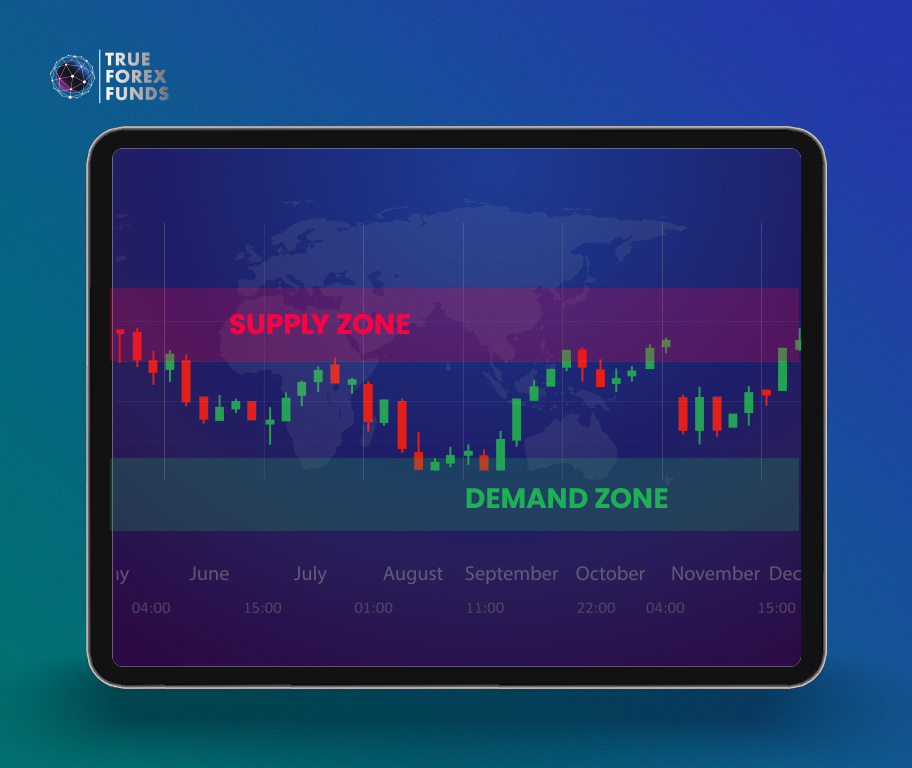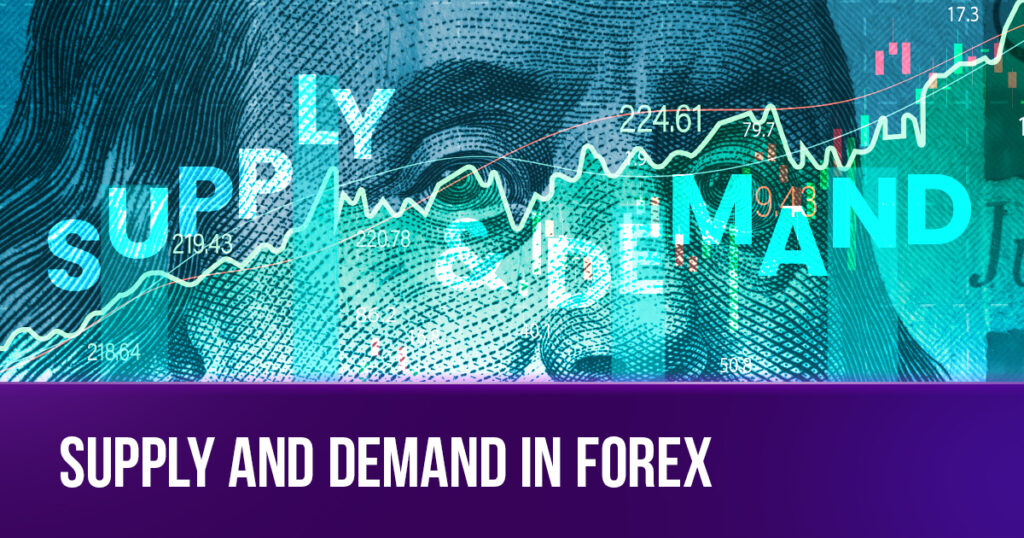Mastering the supply and demand concept is a crucial element for success in forex trading. It’s the driving force behind price changes in forex currency pairs and virtually any tradable asset. In fact, many seasoned traders who specialize in the simple yet effective naked price action trading strategy focus primarily on supply and demand trading.
This comprehensive guide from True Forex Funds help you identify supply and demand zones like a seasoned pro and incorporate them into your trading strategy for maximum advantage.
What are Forex Supply and Demand Zones?
Forex supply and demand zones are chart areas where currency pair prices are likely to change direction due to imbalances between buyers and sellers. These zones form when there’s a significant surge in buying or selling pressure. Traders use them to anticipate price reversals or continuations.
Now, let’s revisit the basics:
In forex trading, supply and demand dictate price changes. High demand (more buyers than sellers) drives prices up, while oversupply (more sellers than buyers) pushes prices down. This principle is fundamental to trading.
But it goes further:
All tradable assets eventually reach an equilibrium, creating supply and demand zones. These zones are pauses in price movement as the market balances between buyers and sellers. Traders rely on this concept to identify trade opportunities.
In forex, factors like economic policies, political events, and market sentiment impact currency supply and demand. For instance, when the US raises interest rates, demand for the US dollar may surge, as investors seek higher returns. Conversely, political turmoil or conflicts may limit foreign investments, reducing the supply of foreign currencies and strengthening the US dollar’s exchange rate.
So, why are these supply and demand levels so crucial in forex trading?
In the world of economics and finance, demand occurs when more people want to buy a particular product, such as gold. When the supply is limited in such a scenario, the product’s price goes up. Conversely, when there’s an excess supply and fewer buyers, the price drops. This principle applies to the forex market as well.
Economic Influence:
Supply and demand forex trading involves analyzing the economic forces influencing currency exchange rates. Traders use this approach to predict where prices might retrace or stall. They also consider how specific FX levels can impact a local economy.
Currency Rates:
It’s worth noting that forex currency rates have a significant impact on a country’s global economy, affecting exporters, importers, and even prompting intervention by local central banks. This intervention can result from pressure exerted by various entities like importers, exporters, or large tech companies.
Factors Affecting Supply and Demand Balance:
Significant players such as institutional investors, hedge funds, and governments play a substantial role. When these entities enter the forex market, they bring substantial buying or selling power that can alter the supply and demand balance. As you become adept at interpreting the forex market, you’ll notice when these institutions enter, making large orders to buy or sell specific currencies.
This is precisely why understanding demand and supply zones is crucial for comprehending price movements. Once you master this approach, you’ll have insight into which zones are pivotal for a particular currency, helping you make profitable buying or selling decisions.
Key Steps for Identifying Supply and Demand Zones in Trading
Identifying supply and demand revolves around the same technique as identifying support and resistance levels. Still, there are some minor differences between the two.
First, here are some steps you need to follow to identify these zones like a pro:
- Start by identifying significant price levels on the chart, such as highs and lows.
- Look for areas on the chart where the price has been consolidating or ranging for an extended period. These zones often indicate a balance between supply and demand.
- Price spikes may indicate a sudden increase in buying or selling pressure, creating a zone of supply or demand.
- Use technical analysis indicators. These tools can help you identify areas or zones where the price might bounce back and create supply or demand zones.
- Read market news and announcements from central bankers about any specific FX levels a local central bank may protect.

Demand Zone
A demand zone refers to a specific region on a price chart characterized by substantial buying strength, leading to either a price surge or a reversal of a declining trend. Identifying a demand zone involves examining chart areas where the price has repeatedly rebounded, signifying the willingness of buyers to engage in the market at that particular level.
In practice, participants in the forex market often enter trades at this price level or exit short-selling positions because they recognize its significance as a formidable price point that is unlikely to be easily breached.
Supply Zone
A supply zone denotes a specific section on a price chart characterized by substantial selling influence, leading to either a price decline or a reversal of an upward trend. Detecting supply zones involves examining price levels where multiple attempts to breach have encountered resistance, signifying heightened selling pressure.
Much like a demand zone, a supply zone signifies an area where market participants anticipate acting as a formidable resistance level.
Supply and demand zones are fundamental in trading as they mark pivotal points for price reversals. True Forex Funds guides you through mastering these zones, ensuring you gain a comprehensive understanding to enhance your trading skills.




